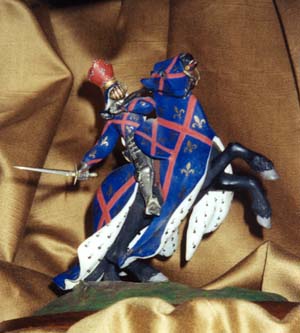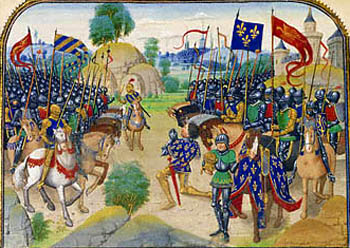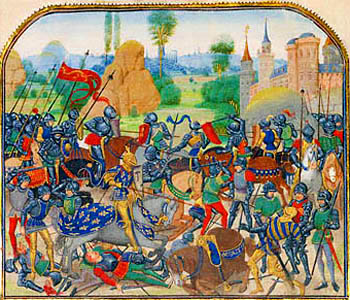 |
The Saint of the Day
St. Emilian of Autun, August 22
Prof. Plinio Corrêa de Oliveira
Biographical selection:
Muslim invasions, which began taking over Spain in 711, soon began to spread across the Pyrenees into various regions of France. In 725, an attack was planned against the city of Autun, rich in abbeys and monasteries. A reaction of the French Catholics rose in Bretagne, led by St. Emilian, Bishop of Nantes.

St. Emilian was a Bishop who led the fight against the Saracens at Autun.
|
Born in a noble family of Armonica, he was famous for his courage and honor. Magnanimous, with keen discernment and a noble character, he had great intelligence as well as a faith worthy of a martyr and an ardent zeal for the interests of the Church. So, when he heard the news that the Muslims would invade Autun, the Bishop considered it his duty to take up the sword. He judged that it was necessary to fight rather than flee and see the things he loved the most destroyed: Catholicism and France.
He called the people to the Cathedral and made this appeal, which became legendary in the Middle Ages:
“O! All you strong men of war who are still stronger in the faith: take into your hands the shield of this divine Faith, mark on your foreheads the sign of the Cross, cover your heads with the helmet of salvation, and protect your chests with the armor of the Lord. Then after taking up this religious armor, soldiers of Jesus Christ, do yet more.
“Take your strongest weapons of war, your sharpest swords of the best steel, and come together to combat and smash the miserable enemies who like furious beasts slaughter our Catholic brothers. It is the moment to say with Judas Macabeus: 'Be strong and make you ready that you may fight with these people, which are agreed together to destroy us and our sanctuary. Better is it for us to die in battle, than to see our people and our sanctuary in such a miserable state.'”
Touched by the Holy Ghost and filled with enthusiasm, the crowd shouted: “Lord and Venerable Pastor, give the order and command, and where you go, we will follow.”
The Saint answered: “On this spot we shall gather and from the foot of this altar we will start out against the enemy. And I will have the honor to march at the head of the soldiers of Jesus Christ.”
On the arranged date, wearing his sacred vestments the Bishop said Holy Mass and gave Communion to the men who would fight with him. Then, they started their march to Autun. A series of marvelous victories followed the Breton army. They saved Autun at the great battle of Saint Forjand, and defeated the infidel army at the pass of Crès d’Aussi.
The enemy made another attack but was defeated at the battle of St. Jean de Louis. The Muslim chief, however, made another maneuver to reconquer Autun. To cut off his path, St. Emilian gathered a number of his subjects and said: “Dear and brave companions, I congratulate you for your great faith. The number of combatants is not important; the victory comes from Heaven.”
Then, making a sign of the Cross, he said, “Lord, into Thy hands I commend my spirit,” and entered into the thick of the fight.
Tradition says that St. Emilian severely wounded the Muslim chief during the fight. When the Saracens saw their chief so near to death, many rallied to help him. The Saint Bishop fell to the ground, fatally wounded by many sword thrusts. He continued to shout encouraging his soldiers, but finally expired. It was August 22, 725.
The Muslim chief ordered St. Emilian beheaded. Later the Catholics gathered his relics, which were treasured as objects of great veneration. His cult was confirmed by Pope Pius IX.
[Seven years after the sack of Autun in 725, Charles Martel met Abd-er-Rahman outside of Tours and defeated and slew him. The Battle of Poitiers of 732 is considered one of the great turning points in History, which stopped the Islamic advance into Western Europe.]
Comments of Prof. Plinio:
The decree of Pope Pius IX is very valuable because it confirms the legitimacy of St. Emilian’s initiative to go into battle, leading his warriors against the Moors, engaging in the fight, and finally reining his horse to the center of battle, where he died from wounds inflicted by the enemies.
There is a principle of Canon Law that states that ecclesiastics should not shed blood with their own hands. Ecclesia abhorrit sanguine, the Church has a horror of blood. She is the mother who doesn’t want to see the blood of her children shed. This is why she forbade her ecclesiastics to enter into combat.

The soldiers gather for prayer before going into battle

There are exceptions to the rule, like the case of St. Emilian, that permit ecclesiatics to enter into battle.
Histoire de Charles Martel , J. Paul Getty Museum
|
But that principle doesn’t go so far as to affirm that bloodshed is never permitted. There were the Crusades, for example, that were called by the Church. What is the wise criteria behind this rule and its exceptions?
Let us imagine a village where a certain villain became famous for his crimes and evil behavior. The man is justly condemned to death, and the judge needs someone to execute the sentence. Let us suppose that the men who would normally do this had gone to war, and the only one left who could execute the sentence was the father of the bandit. Must the father hang the son? What does Catholic Morals says about such a situation?
The Church teaches that even if the son is clearly guilty and deserves death, the father is dispensed from executing the sentence. According to Natural Law a father should not kill his own son. The father can agree that his son is guilty and deserves to die, he can encourage others to execute the sentence, but he should not have to do it. The judge should wait for another person to execute the sentence.
An analogous situation governs Church policy regarding the shedding of blood. She can agree that bloodshed is necessary, she can encourage it, she can canonize those who do so; but since she is the mother, she does not do so. There is no contradiction, it is a refinement of moral sensitivity. This is the extremely beautiful rule.
So, Bishops and priests did not shed the blood of others. But it is also very beautiful that some exceptions existed to this rule. One such exception is that of St. Emilian who took up arms in a defensive war against the enemies of the Church, rousing the people to action, encouraging the faithful to fight, and entering the battle himself after he said the Mass that began the military effort at the foot of the altar. It is a very beautiful exception that we should understand and admire.
So we have St. Emilian who as a Bishop commanded an army, defeated the Saracens, and when they tried a final maneuver to regain the city, went straight into the heart of the battle to save the city. Having a presentiment he would die, he repeated the last words of Our Lord: “My God, into Thy hands I commend my spirit.” He died uniting two forms of glory: the glory of the victor and the glory of the defeated.
The glory of the victor because he saved the city. The glory of the defeated because he accepted the fact he would die and offered his life to God, knowing that in Heaven’s eyes, he was a victor. With this, he joyfully entered Paradise. He united the two kinds of glory.
His last words were to encourage his warriors to continue the fight. He didn’t indulge in any pity for himself or regret for his death. His last words were words of combat.
Can we imagine a more beautiful death?
Let us ask St. Emilian to give us his militant spirit and to cure us of any traces of bad ecumenism, sentimentalism, or self-pity we might have in order to serve Holy Mother Church whenever and wherever she needs us, and then, in victory or defeat, enter Paradise.


  | | Prof. Plinio Corrêa de Oliveira | |
The Saint of the Day features highlights from the lives of saints based on comments made by the late Prof. Plinio Corrêa de Oliveira. Following the example of St. John Bosco who used to make similar talks for the boys of his College, each evening it was Prof. Plinio’s custom to make a short commentary on the lives of the next day’s saint in a meeting for youth in order to encourage them in the practice of virtue and love for the Catholic Church. TIA thought that its readers could profit from these valuable commentaries.
The texts of both the biographical data and the comments come from personal notes taken by Atila S. Guimarães from 1964 to 1995. Given the fact that the source is a personal notebook, it is possible that at times the biographic notes transcribed here will not rigorously follow the original text read by Prof. Plinio. The commentaries have also been adapted and translated for TIA’s site.
|
Saint of the Day | Home | Books | CDs | Search | Contact Us | Donate

© 2002- Tradition in Action, Inc. All Rights Reserved
|
 |

|